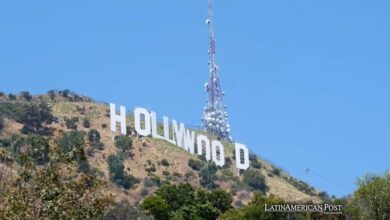“Triangle of Sadness”: A Satire of the Rich or for the Rich?
In Ruben Östlund's new film, the passengers of an exclusive luxury liner face the will of a storm and a Marxist captain. This is our review of the Palme d'Or winner and three-time Oscar nominee, "Triangle of Sadness".

Photo: Apple TV
LatinAmerican Post | Juan Andrés Rodríguez
Listen to this article
Leer en español: “Triángulo de la tristeza”: ¿Una sátira de los ricos o para los ricos?
Cinema and television, since their inception, have been fundamental means to make visible and criticize the dynamics of social classes. There is nothing new in which movies or series satirize wealth. But in recent years, the increase in productions that focus on this theme and seek to ridicule it from the absurd is notable.
Added to this repertoire is "Triangle of Sadness," the new film by Ruben Östlund ("Turist," "The Square") and winner of the Palme d'Or at the 2022 Cannes Film Festival. The models and influencers Carl ( Harris Dickinson) and Yaya (Charlbi Dean) are invited on a luxury cruise, accompanied by a group of absurdly wealthy people. In this "paradise" in the middle of the ocean, the order is to fulfill all the wishes of its passengers, which does not sit very well with the Marxist ideology of the captain (Woody Harrelson). The social order and power dynamics are subverted when a storm hits the ship.
Associated with the subgenre of "eat the rich" —a name originated by the phrase of the French revolution, "When the people no longer have what to eat, they will eat the rich." In these titles, such as "Parasite," "White Lotus," "Succession," "The Menu" and "Glass Onion," the questions arise: what is the contribution of the "Triangle of Sadness" to the discourse on the "1%" of the population? And if it is a criticism of the rich or for the rich.
A Storm of Topics
The film is structured in three parts, and in each one, its intention to prove points about the dynamics of power in the capitalist market is denoted. Topics are abundant such as gender roles, the body as merchandise, the contempt and invisibility of workers in the service industries, and the origin of the so-called original accumulation, to name a few. It is as if Östlund had read Marx's "Capital" and was fascinated. He had made a list of his favorite elements, which he would address in a film. He tries to incorporate them as much as possible and goes from one to the other most efficiently to him as if it were a to-do list. The result is highly memorable moments, with bold dialogue but a disjointed narrative.
The script's thematic ambition is recharged in the second part, which focuses on the extravagance and immaturity of wealthy people. Although his staging to represent this is very ingenious, there is a repetition that leads to the point of boredom, and the weight of more than two and a half hours is felt. This comes at a cost in pacing and character development.
The cast is incredible, but it results in a one-dimensional development. Fully working the environment to the themes of power and capitalism reduces the purpose of the characters to prove a point. Carl and Granny are representations of adulation by Western beauty standards, which turn their bodies into marketable commodities. The captain embodies socialism with awareness of inequality as the basis of wealth and resignation to market forces. Thus, each can be listed, which does not mean the performances are wrong.
With that said, it's worth praising Dolly De Leon's performance as Abigail. His role is fundamental, but it only comes into focus in the third part, and that is why it is more enjoyable if the details are unknown. De Leon steals the spotlight in every scene and is probably the only one with a complex story arc. It was surprising and disappointing that the film received more Oscar nominations than expected—mainly Östlund's for Best Director—but De Leon was still left out of the Best Supporting Actress category.
Also Read: Black History Month: 6 Movies You Must See
From Caricature to Absurd
A common criticism of the film is that it is presented as a satire of extreme wealth intended to make billionaires uncomfortable. Still, it is a product for the entertainment of these self-critical audiences. It is a caricatural portrait that aims to ridicule them, to demonstrate how they are disconnected from reality and cynically turn others into a means to an end, however small.
There are brilliant scenes to demonstrate this, particularly one that gives a new or very literal meaning to the phrase "filthy rich." But his constant commitment to the absurd makes him fall so far into the improbable that his comments about the "1%" are not sharp, who will probably enjoy the film more than a casual viewer.
Given the wave of productions that seek to mock privilege, "Triangle of Sadness" does not stand out as a satire on wealth and capitalism. It has surprising, quirky, funny moments, good performances, and memorable Marxist economics phrases. Still, it pales compared to other productions—a recommendation to see Luis Buñel's "The Discreet Charm of the Bourgeoisie" (1972)— more memorable and better. It is achieved from the same speech.




